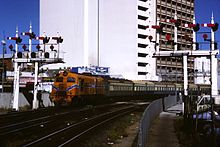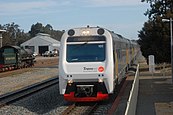 An Australind at
Bunbury in January 2014 | |||||
| Overview | |||||
|---|---|---|---|---|---|
| Service type | Passenger train | ||||
| Status | Suspended | ||||
| Locale | South West Western Australia | ||||
| First service | 24 November 1947 | ||||
| Last service | 19 November 2023 | ||||
| Current operator(s) | Transwa | ||||
| Former operator(s) |
WAGR (1947–1975) Westrail (1975–2000) WAGR Commission (2000–2003) | ||||
| Ridership | 60,507 (year to June 2022) | ||||
| Route | |||||
| Termini |
Perth Bunbury | ||||
| Stops | 13 | ||||
| Distance travelled | 167 kilometres | ||||
| Average journey time | 2 hours 30 minutes | ||||
| Service frequency | Twice daily | ||||
| Train number(s) | 9/10 | ||||
| Line(s) used | South Western Railway | ||||
| Technical | |||||
| Rolling stock | ADP/ADQ class railcars | ||||
| Track gauge | 1,067 mm (3 ft 6 in) | ||||
| |||||
The Australind is a currently suspended rural passenger train service in Western Australia operated by Transwa on the South Western Railway between Perth and Bunbury.
The Australind was suspended in November 2023 due to the shutdown of the Armadale line for upgrading, and pending retirement of the current rolling stock. The route has been replaced by coach bus services until mid-2025. [1]
History

The Australind service began on 24 November 1947 and was hauled initially by U class steam locomotives. [2] With an average speed of 63 km/h (39 mph), it was the fastest narrow gauge passenger train in Australia. [3] It was named to commemorate the city of that name envisioned by Marshall Waller Clifton on Leschenault Inlet 100 years previously. The current hamlet of Australind, a satellite town of Bunbury, has never had a passenger rail service, nor even a railway line.
In February 1958, X class diesel locomotives took over. The service was relaunched on 1 October 1960 with onboard catering removing the need for an elongated stop at Pinjarra. On 16 November 1987, the current ADP/ADQ class railcars took over the service reducing journey times to 2 hours 30 minutes. [4] [5] [6] [7]
In November 2023 the service was suspended due to the shutdown of the Armadale line for upgrading. [1] The final two services on the current train sets - reserved for invited special guests - were conducted on 18 and 19 November 2023. [8]
Rolling stock
When introduced, the train consisted of new carriages built by the Midland Railway Workshops. [5] In August 1985, Westrail awarded Comeng, Bassendean a contract for five Westrail ADP/ADQ class railcars, three ADPs with driving cabs and two ADQs, using a similar body shell and interior fitout to the New South Wales XPT carriages. [9] Each carriage was powered by a Cummins KTA19 coupled to a Voith transmission. They usually operate as a three or four carriage set. Five carriage set operation is not possible due to the limited platform length available at Perth station. [6]
In July 2003, the trains were painted in a new livery in line with the formation of Transwa. In 2007, the trains were painted white as part of a refurbishment program. In 2010/11, new seats were fitted. [10]
In 2019, two new train sets, each consisting of a three-car diesel multiple unit, were ordered for the Australind at a cost of $54 million. The trains will be built by Alstom in Bellevue as diesel-powered variants of the Transperth C-series trains already under construction. The new train sets will be introduced to the service when the route resumes in 2025. [11] [12] [13]
Route
The Australind departs from Perth traversing the metropolitan Armadale line to Armadale, then the South Western Railway to Bunbury. [14]
Stations
- Perth
- Armadale
- Byford
- Mundijong
- Serpentine
- North Dandalup
- Pinjarra
- Waroona
- Yarloop
- Cookernup
- Harvey
- Brunswick Junction
- Bunbury
Ridership
The Australind had 60,507 passengers in the year leading up to June 2022. [15]
See also
References
- ^ a b "Australind service changes". Transwa. Public Transport Authority. Retrieved 4 February 2024.
- ^ "The Australind – Fast Day Train to Bunbury". Kalgoorlie Miner. 26 November 1947. p. 1. Retrieved 10 July 2014.
- ^ Gunzburg, Adrian (1984). A History of WAGR Steam Locomotives. Perth: Australian Railway Historical Society. p. 128. ISBN 0-9599690-3-9.
- ^ May, Andrew S; Gray, Bill (2006). A History of WAGR Passenger Carriages. Midland, WA: Bill Gray. pp. 183, 312, 314. ISBN 0646459023.
- ^ a b Higham, Geoffrey (2007). Marble Bar to Mandurah: A history of passenger rail services in Western Australia. Bassendean: Rail Heritage WA. pp. 111, 113, 119. ISBN 978-0-9803922-0-3.
- ^ a b Dunn, John C. (2013). "Perth-Bunbury Railcars". Comeng: A History of Commonwealth Engineering Volume 5, 1985-2012. Dural, NSW: Rosenberg Publishing. pp. 113–122. ISBN 9781925078046.[ permanent dead link]
- ^ "Australind Timetable" (PDF). Transwa. Public Transport Authority. Archived (PDF) from the original on 28 June 2020. Retrieved 28 June 2020.
- ^ "End of an era: Australind train farewelled after 36 years serving communities between Bunbury and Perth". Harvey-Waroona Reporter. Retrieved 4 February 2024.
- ^ "Western Australia" Railway Digest September 1985 page 279
- ^ Annual Report June 2011 Archived 27 March 2015 at the Wayback Machine Public Transport Authority
- ^ Minister for Transport (18 August 2019). "Made in WA: Metronet railcars to be proudly built in WA". Archived from the original on 5 September 2019.
- ^ "Alstom to supply next generation of EMUs to Perth". Metro Report International. 20 August 2019. Archived from the original on 3 September 2019.
- ^ "New Australind Railcar Design Unveiled". Railway-News. 23 January 2020. Archived from the original on 11 April 2022. Retrieved 11 April 2022.
- ^ "Our fleet". Public Transport Authority. Perth, WA: Government of Western Australia. Archived from the original on 29 November 2018. Retrieved 5 February 2015.
- ^ "Public Transport Authority Annual Report 2021-22" (PDF). Public Transport Authority. 2022. p. 21. Archived (PDF) from the original on 18 December 2022. Retrieved 8 January 2023.
External links
-
 Media related to
Transwa Australind at Wikimedia Commons
Media related to
Transwa Australind at Wikimedia Commons - Perth Trains gallery (archived)


